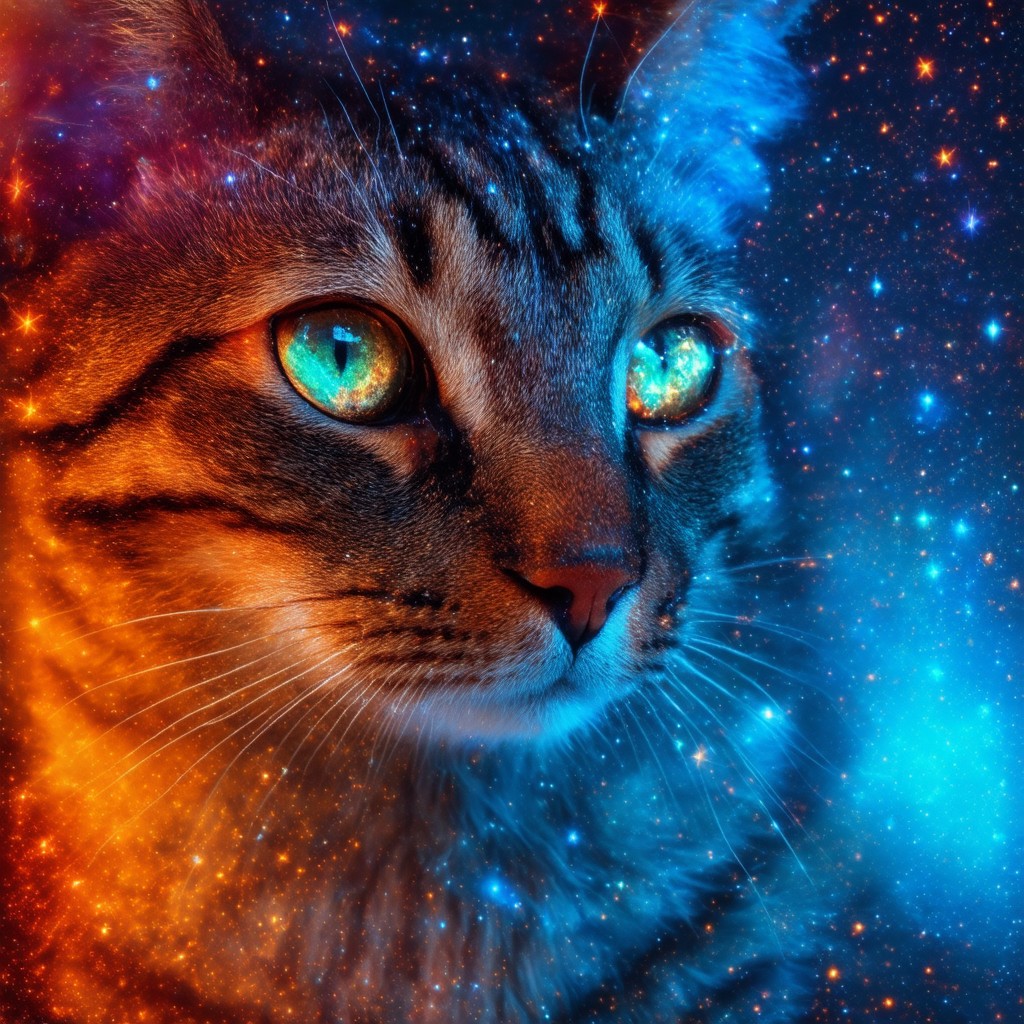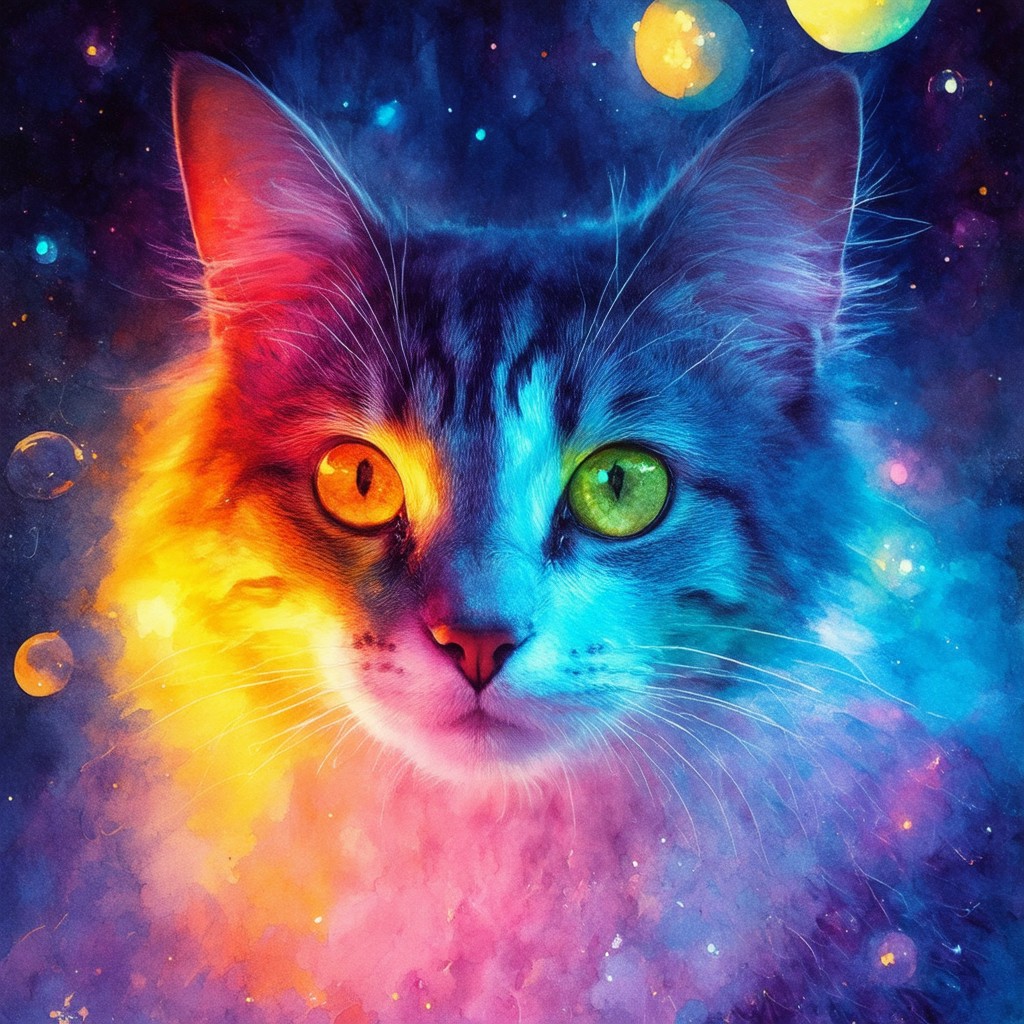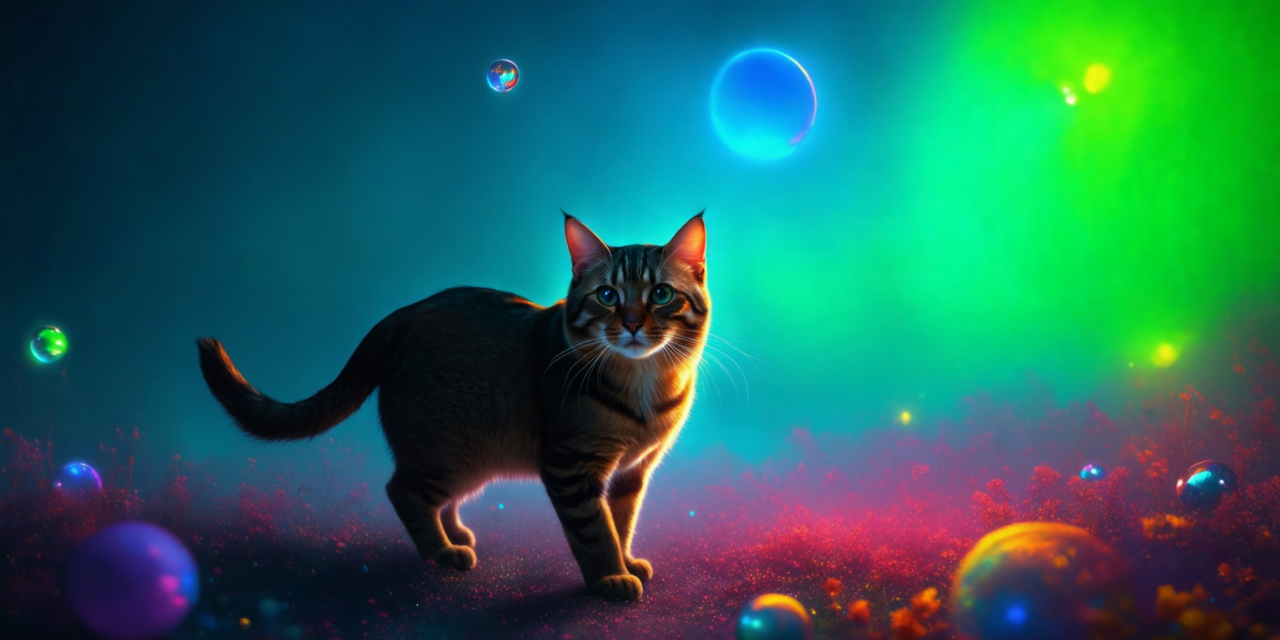Key Takeaways
- Color Perception: Cats primarily see shades of blue and green, struggling with reds and pinks, which appear gray, due to their dichromatic vision.
- Exceptional Night Vision: Cats can see in light levels six times lower than humans, thanks to their higher rod cell count and the tapetum lucidum, making them adept nocturnal hunters.
- Wide Field of Vision: With a field of view of approximately 200 degrees, cats are better at detecting motion and potential prey compared to humans.
- Visual Acuity: While their visual acuity ranges from 20/100 to 20/200, cats excel in detecting movement, crucial for their predatory behavior.
- Recognition Skills: Cats recognize their owners primarily through scent and sound rather than visual cues, indicating a unique social interaction style.
Welcome to our in-depth exploration of cat vision, where we unravel the fascinating ways in which our feline friends perceive the world around them. Have you ever wondered what colors can cats see or how their unique night vision capabilities allow them to navigate in low light? In this article, we will delve into the intricacies of cats’ vision, comparing it to human eyesight and uncovering the key differences that define their visual experience. From understanding the cat vision color spectrum to exploring common cat eyesight problems, we will provide valuable insights into how cats see the world. Additionally, we will address intriguing questions such as do cats recognize faces and what does cat vision look like. Join us as we embark on this enlightening journey to better understand feline vision and the remarkable adaptations that make cats such extraordinary creatures.
What does a cat’s vision look like?
Cats possess a unique vision that differs significantly from humans. Here’s a comprehensive overview of what a cat’s vision looks like:
Cat vision color: Understanding the spectrum
Cats have dichromatic vision, meaning they primarily see shades of blue and green. They struggle to perceive reds and pinks, which may appear as shades of gray or brown. This limited cat vision spectrum is due to the presence of fewer cone cells in their retinas compared to humans. Additionally, their eyes are equipped with a special layer called the tapetum lucidum, which enhances their ability to see in low light, making them exceptional nocturnal hunters.
How do cats see the world? A closer look at feline vision
One of the most remarkable aspects of a cat’s vision is their ability to see in low light. Cats have a higher number of rod cells, which are sensitive to dim light, allowing them to see in conditions that would be nearly pitch black for humans. They require only one-sixth of the light that humans need to see effectively. This adaptation is crucial for their hunting instincts, as they can detect movement even in the darkest environments.
Cats also have a wider field of vision, approximately 200 degrees compared to the human field of about 180 degrees. This broader perspective helps them detect movement and potential prey from various angles. However, while cats excel in detecting motion, their depth perception is not as refined as that of humans. This is due to the placement of their eyes, which are more forward-facing, providing better binocular vision but less peripheral awareness.
In summary, a cat’s vision is adapted for survival, emphasizing low-light conditions and motion detection over color and detail. Understanding these aspects can enhance our appreciation of feline behavior and needs. For further reading on animal vision, refer to studies published by the ASPCA and resources from the Cornell University College of Veterinary Medicine.

How Good Is a Cat’s Eyesight?
Understanding how good a cat’s eyesight is reveals fascinating insights into their unique visual capabilities. While cats may not have the same level of visual acuity as humans, their eyesight is perfectly adapted for their predatory lifestyle. Cats possess a unique visual system that allows them to excel in their environments. Their visual acuity ranges from 20/100 to 20/200, indicating that they need to be within 20 feet to see what a human can see from 100 to 200 feet away. While this suggests their vision is not as sharp as that of humans, it is well-adapted for their predatory lifestyle.
Cat Vision vs Human Vision: Key Differences
- Field of View: Cats have a broader field of view, approximately 200 degrees compared to the human field of about 180 degrees (Business Insider). This expanded peripheral vision enables them to detect movement and potential prey more effectively.
- Low Light Vision: One of the most remarkable aspects of a cat’s eyesight is its ability to see in low light conditions. Cats have a higher concentration of rod cells in their retinas, which are sensitive to dim light. Additionally, they possess a “tapetum lucidum,” a reflective layer behind the retina that enhances light capture, allowing them to see in light levels six times lower than what humans can perceive (Hill’s Pet Nutrition; Animal Eye Guys).
- Color Perception: While cats can see color, their color vision is limited compared to humans. Research indicates that they can distinguish between blues and yellows, but reds and greens may appear as shades of gray (Cats Protection; Quora). This suggests that cats primarily rely on brightness and movement rather than color differentiation when hunting or navigating their surroundings.
- Hunting Adaptations: The combination of their excellent night vision, wide field of view, and motion detection makes cats highly effective hunters. They are naturally equipped to spot and track prey even in low-light conditions, which is crucial for their survival.
In summary, while a cat’s eyesight may not be as sharp as a human’s, it is finely tuned for their ecological niche, allowing them to thrive as nocturnal hunters. Understanding these visual capabilities can enhance our appreciation of feline behavior and needs.
Do Cats Have Better Vision Than Humans? Exploring the Facts
When comparing cat vision to human vision, it becomes clear that each species has evolved visual traits suited to their specific needs. While humans excel in color discrimination and detail recognition, cats shine in low-light environments and motion detection. This leads to the question: do cats have better vision than humans?
- Night Vision: Cats are known for their exceptional night vision, which allows them to navigate and hunt in darkness. Their ability to see in low light is significantly better than that of humans, making them adept nocturnal hunters. This is due to their higher number of rod cells and the presence of the tapetum lucidum, which reflects light back through the retina.
- Motion Detection: Cats are highly sensitive to movement, which is crucial for spotting prey. Their visual system is designed to detect even the slightest motion, giving them an advantage in hunting scenarios.
- Color Vision: Although cats can see some colors, their perception is limited compared to humans. They primarily see shades of blue and yellow, while reds and greens are less distinguishable. This limitation does not hinder their hunting abilities, as they rely more on motion and brightness.
In conclusion, while cats may not have “better” vision in terms of clarity and color perception, their eyesight is perfectly adapted for survival in their natural habitats. Understanding these differences can help cat owners appreciate their pets’ unique abilities and needs.
Is Cat Vision Blurry?
Cats have a unique visual system that differs significantly from humans, leading to some misconceptions about their vision quality. While they possess remarkable adaptations for hunting, certain aspects of their eyesight can contribute to a perception of blurriness.
Cat Eyesight Problems: Common Issues and Solutions
Understanding cat eyesight problems is crucial for ensuring your feline friend’s health. Common issues include:
- Visual Acuity: Cats possess lower visual acuity compared to humans, which means they struggle to see fine details. Their ability to discern objects is not as sharp, particularly at distances, contributing to a perception of blurriness in their vision.
- Nearsightedness: Cats are naturally nearsighted, making it challenging for them to focus on distant objects. This characteristic is advantageous for their hunting instincts, allowing them to detect movement and prey that is closer to them.
- Color Vision: Contrary to the belief that cats see only in black and white, they can perceive colors, albeit in a more limited spectrum. Research indicates that cats primarily see shades of blue and green, but their color perception is less vibrant than that of humans.
- Night Vision: One of the most remarkable aspects of cat vision is their exceptional night vision. Cats have large pupils and a reflective layer behind the retina called the tapetum lucidum, which enhances their ability to see in low-light conditions.
To address these issues, regular veterinary check-ups are essential. If you notice signs of cat vision problems, such as difficulty navigating or changes in behavior, consult a veterinarian for a thorough examination.
How to Tell if Your Cat Has Vision Problems: Signs to Watch For
Recognizing how to tell if your cat has vision problems is vital for their well-being. Look for these signs:
- Disorientation: If your cat seems confused or disoriented in familiar environments, it may indicate vision issues.
- Changes in Behavior: A sudden change in behavior, such as increased aggression or withdrawal, can signal discomfort related to eyesight.
- Difficulty Jumping: Cats rely on their vision to judge distances. If your cat hesitates or struggles to jump onto furniture, it may be a sign of vision impairment.
- Eye Discharge or Redness: Any noticeable changes in the eyes, such as discharge or redness, should prompt a visit to the vet.
By being attentive to these signs, you can help ensure your cat maintains optimal health and well-being. Regular veterinary visits and prompt attention to any changes in behavior are key to addressing potential cat eye problems.
What do cats see when they look at you?
Cats have a unique way of perceiving the world, which significantly differs from humans. Here’s a detailed look at what cats see when they look at you:
- Color Perception: Cats have a limited color spectrum compared to humans. They can see blues and greens but struggle with reds and pinks, which may appear as shades of gray or green. This is due to the presence of fewer cone cells in their retinas, which are responsible for color detection (Source: American Veterinary Medical Association).
- Night Vision: One of the most remarkable aspects of a cat’s vision is their ability to see in low light. Cats have a higher number of rod cells, which are sensitive to dim light, allowing them to see in conditions that would be nearly dark for humans. This adaptation is essential for their crepuscular hunting habits (Source: National Geographic).
- Peripheral Vision: Cats possess a wider field of vision, approximately 200 degrees compared to the human range of about 180 degrees. This enhanced peripheral vision helps them detect movement and potential threats from various angles (Source: Veterinary Clinics of North America).
- Facial Recognition: While cats can recognize their owners, they do so primarily through scent and sound rather than visual cues. Studies suggest that cats may not rely on facial recognition as much as dogs do, indicating a different social interaction style (Source: Journal of Veterinary Behavior).
- “Human-as-Cat” Theory: Some researchers propose that cats perceive humans as larger, less agile versions of themselves. This perspective influences how they interact with us, often treating humans similarly to how they would engage with other cats (Source: Animal Behavior Science).
- Staring Behavior: When a cat stares at you, it can signify various emotions. A slow blink is often interpreted as a sign of affection, while a direct stare may indicate curiosity or, in some cases, discomfort or aggression. Understanding these cues can enhance the bond between you and your feline friend (Source: Cat Behavior Associates).
Cats vision POV: Understanding their perspective
When you consider a cat’s perspective, it becomes clear that their vision is adapted for survival. Their ability to detect movement is finely tuned, making them excellent hunters. The way they see the world is influenced by their evolutionary background as crepuscular predators. This means they are most active during dawn and dusk, which aligns with their enhanced night vision capabilities. Understanding this perspective can help cat owners appreciate their pets’ behaviors and needs.
Do cats recognize faces? The science behind feline recognition
While cats can recognize their owners, they do not rely heavily on visual recognition like dogs. Instead, they use a combination of scent and sound to identify familiar people. Studies indicate that cats may not see human faces as distinct entities but rather as part of a broader environment. This unique recognition method highlights the importance of understanding feline behavior and communication, allowing for a deeper bond between cats and their owners.

Do Cats Recognize Faces?
Cats do recognize faces, but their method of recognition differs from that of dogs. Here are key points regarding how cats identify individuals:
- Recognition through Other Senses: Cats primarily rely on their acute sense of smell and hearing to identify people. Their olfactory system is highly developed, allowing them to recognize their owners through scent, which plays a crucial role in their social interactions.
- Visual Recognition: While cats can recognize human faces, studies indicate they are not as proficient as dogs. Research published in the journal Animal Cognition found that cats could distinguish their owner’s face from a stranger’s face approximately 55% of the time, suggesting a moderate level of visual recognition.
- Social Cues: Unlike dogs, cats are less motivated by social cues from humans. This difference may influence their engagement in activities that require facial recognition, making them appear less responsive to human expressions.
- Emotional Recognition: Cats are capable of interpreting human emotions, particularly when facial expressions are combined with vocal tones. For instance, they can differentiate between happy and angry faces, which can affect their behavior towards their owners.
- Research Insights: A study conducted by researchers at the University of Tokyo in 2019 highlighted that cats can recognize their owners’ voices and respond accordingly, further supporting the idea that they have a unique way of acknowledging familiar individuals.
In conclusion, while cats may not excel in facial recognition compared to dogs, they utilize a combination of sensory cues and emotional context to recognize their owners. Understanding these behaviors can enhance the bond between cats and their owners, promoting a harmonious relationship.
Cat Vision Simulation: Visualizing Their Perception
To better understand how cats perceive the world, we can utilize a cat vision simulation. This tool illustrates the differences in color perception and clarity between cats and humans. Cats have a unique cat vision color spectrum that allows them to see certain colors differently. They are believed to see blues and greens more vividly, while reds and pinks may appear more grayish to them. This limited color perception is due to the fewer cone cells in their retinas compared to humans.
Additionally, the simulation highlights how cats’ vision is adapted for low-light conditions. Their eyes contain a higher number of rod cells, which are sensitive to dim light, enhancing their cat night vision. This adaptation allows them to navigate effectively in the dark, making them proficient hunters during twilight hours. Understanding this aspect of cat vision can help pet owners create a more enriching environment that caters to their feline companions’ natural instincts.
What animal has the best vision?
When discussing the best vision in the animal kingdom, the eagle, particularly the golden eagle, stands out as the champion. Eagles possess remarkable visual acuity, estimated at 20/5, allowing them to see at 20 feet what a human with 20/20 vision can only see at 5 feet. This extraordinary capability enables them to spot prey from distances of up to 2 miles. Their fovea structure is deeper than that of humans, functioning like a telephoto lens, which enhances their focus on distant objects with incredible detail.
In comparison, cats also exhibit impressive visual abilities, particularly in low-light conditions. While they may not match the eagle’s acuity, their cat vision is adapted for hunting at dawn and dusk, showcasing their nocturnal prowess.
Cat vision vs dog vision: Who sees better?
When comparing cat vision vs dog vision, it becomes evident that both species have unique adaptations suited to their lifestyles. Cats have superior night vision, thanks to a higher number of rod cells in their eyes, which are sensitive to low light. This adaptation allows them to navigate and hunt effectively in dim conditions. In contrast, dogs have a broader field of vision and are better at detecting motion, making them excellent companions for various activities.
Ultimately, while cats excel in low-light environments, dogs may have the edge in terms of motion detection and overall visual field. Understanding these differences can help pet owners appreciate the unique capabilities of their furry companions.
Can cats see in the dark? Unraveling their night vision capabilities
Yes, cats can see in the dark, a feature that stems from their evolutionary background as nocturnal hunters. Their cat night vision is significantly enhanced by their ability to reflect light through a layer of tissue called the tapetum lucidum, which improves their vision in low-light conditions. This adaptation allows them to see well in the dark, making them effective predators during twilight hours.
In summary, while the eagle holds the title for the best vision overall, cats possess remarkable adaptations that allow them to thrive in low-light environments, showcasing their unique cats vision capabilities.
Cat night vision vs human: A comparative analysis
Understanding cat night vision compared to human vision reveals fascinating differences that highlight the unique adaptations of felines. Cats are equipped with a superior ability to see in low-light conditions, which is essential for their predatory lifestyle. This enhanced vision is primarily due to a higher number of rod cells in their retinas, which are responsible for detecting light and movement. In fact, cats can see in light levels six times lower than what humans require to see clearly.
Cats vision at night: How they navigate in low light
When it comes to cats vision at night, their eyes have several adaptations that facilitate excellent night vision. One key feature is the tapetum lucidum, a reflective layer behind the retina that amplifies light. This structure not only enhances their ability to see in the dark but also gives their eyes that characteristic glow when light hits them at night. Additionally, the wide pupils of a cat’s eyes allow more light to enter, further improving their ability to navigate in dim environments.
Cat eyesight at night: Understanding their nocturnal vision
Feline vision is specifically adapted for hunting during twilight hours, known as crepuscular activity. This means that cats are most active during dawn and dusk, times when their cat night vision is at its peak. Unlike humans, who rely on color vision and detail, cats focus on movement and contrast, making them exceptional hunters even in near darkness. Their ability to detect motion is crucial for spotting prey, even in low-light conditions.













